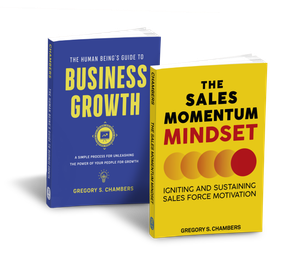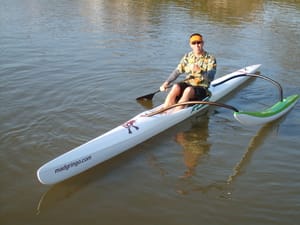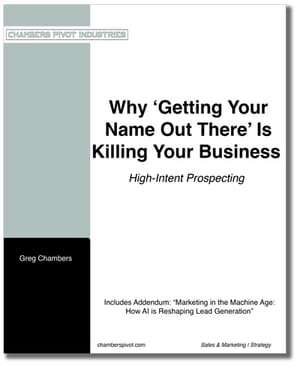Business Growth Ideas #295 This week: Jumping conclusions, Attribution, Judgement

GREG'S BUSINESS GROWTH NEWSLETTER #295
Quick notes to help you grow your business in less time with less effort. . . sometime next week.
In this issue:
- Techniques for FIT
- Being Human
- Random Stuff
Techniques for FIT
- Jumping to conclusions is part of how we're wired. To help catch wrong conclusions, ask yourself if the opposite of your conclusion is possible too.
- Have an eye and ear for evidence. When you hear, "We need to get rid of these refunds!" find out if it's a feeling, or a number on a report. It's ok to have anecdotal evidence to start, but ask if someone involved will want harder evidence at some point, like the CFO.
- Allowing perspective to creep in keeps news cycles from being too distracting. How much has changed, really? Take a step back and reconsider. It's useful to listen to news that's a week or two behind because perspective is built in.
- Next time you find yourself thinking should I do X or Y, ask, "What would have to happen for me to do both?" Your subconscious will get working on a solution. It works.
Being Human - Attribution ------------------------------------------------------------
". . .we judge ourselves by what we feel capable of doing, while others judge us by what we have already done."
– H.W. Longefellow

I am making my way through Daniel Kahneman's new book, "Noise." He has me thinking about predicting future performance in complex domains, like hiring. When the experts measure how well we predict the future, they find we're barely better than chance.
I have a recent example. Both candidates came across my desk during a project and I happen to know both of them. Exceptionally talented individuals vying for a leadership position in a crowded field of talented people.
One candidate led a high-flying startup which came crashing down to earth in a dramatic way. When looking at the failure of this business, it's obvious to blame of the CEO and the selection committee did just that. I happen to know the industry the candidate was competing in relied on volatility and this job was to get market share in a calm environment. Hard work. Was he bad at his job or was it just bad luck?
The second candidate I knew came to the committee from a successful exit. The company she managed grew by leaps and bounds due in part to her efforts, doubling or tripling revenues each year. The committee loved her. The industry she competed in was on fire. In the time period she was at the helm, the market grew even faster than her company did. It was like she was selling phone cases and the iPhone came about. They were riding a wave and held on. Hard work. Was she amazing at her job or was it just good luck?
This is why hiring is so hard. We have to make judgments where there is no comparison. We can't see what a different CEO would have done in the same situation. The committee had no idea if another executive could have been even more successful than the talented woman they had before them.
Recognizing this from the start lets us do things like create a hiring algorithm and scoring system. Each member of the committee scores the candidates using a pre-determined set of guidelines. Make a process and stick to it.
Over time, you may just predict future performance better than chance.
Random stuff

We're all packed up in the truckster, including the Skybox riding high on top. The goal is to move child #3 to school for his senior year of college. With our kids being 4 years apart, this makes the twelfth straight year we've made a trip similar to this. It's a bittersweet moment.
For the first half of the trip I get the opportunity to impart some last bits of wisdom. Our youngest is bright, active, and a joy to be around but is sometimes lacking in the planning department. As we hit the road we know many items were left behind. The words of wisdom center on judgement and foresight and the advantages of thinking two steps ahead through multiple scenarios. Solid Dad stuff. A great lesson, albeit an abstract one.
We get to the hotel, check in, and drive the car around to the garage. As I take the ticket I see the bright yellow bar hanging down at the entrance. 7'4" clearance, it says. I have no idea how high my truck sits with this fancy high impact plastic box on top, but it's late, we've been driving for six hours, and I just nick the bottom of the warning bar as we drive through. It's close to 7'4".
We need to get to level F for the bridge to the hotel, and on the way up about every 3rd concrete support we drive under scrapes just a bit of high-impact ballistic grade plastic off the top of the box. Zzrrtt. When we stop I get out and check the damage. Superficial at the most. We should be good.
The next morning we are to meet child two and his fiance for breakfast. I'm careful on the way down the ramp, swinging wide on the turns, and making very little scraping contact. When I get to the exit, there is a box just outside the garage that looks a little lower than what we've been driving through. Just past the sign is another hotel where I notice around 13 people gathered on the circular entry, waiting for a ride or something. It may be a trick of the mind, but I think one of them is raising a hand to me, like I know them.
The sign is low. I try to avoid it by slowly exiting sideways, and the roof box makes a terrible, terrible noise. It's bad enough that everyone at the other hotel turns, points, and is wincing as I drive by. It's like the garage took a can-opener to my high-impact ballistic plastic box and zippered it open. So embarrassing.
They say there is no better teacher than experience. The garage episode demonstrates of lack of foresight, not thinking ahead, and bad judgement. A concrete example, if you will.
Lesson delivered.
It's what I do.
------------------------------------------------------------If you need to set up a time to visit, follow this link:
https://calendly.com/chamberspivot/





